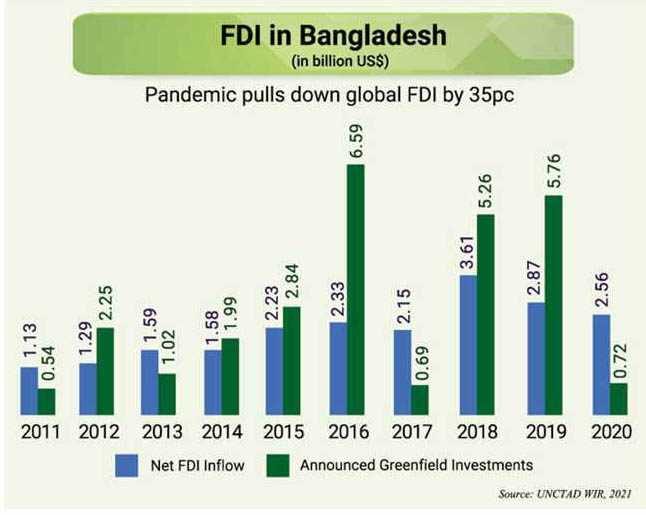
FDI inflow drops 10.80pc in 2020
Recovery hamstrung for greenfield investment downturn: UNCTAD
ASJADUL KIBRIA | Tuesday, 22 June 2021
The net inflow of foreign direct investment (FDI) to Bangladesh declined 10.80 per cent to US$ 2.56 billion in 2020 from $2.87 billion in 2019 in line with the global trend amid Covid pandemic.
The global FDI dropped by 35 per cent in 2020 due to the Covid-19 pandemic, according to the United Nations Conference on Trade and Development (UNCTAD).
It came down to below $1.0-trillion (or $998.91 billion) in 2020 after six years from $1530.28 billion (or $1.53 trillion) in 2019.
The UNCTAD World Investment Report-2021, released on Monday in Geneva, painted the picture.
"Lockdowns caused by the COVID-19 pandemic around the world slowed down existing investment projects, and the prospects of a recession led multinational enterprises to reassess new projects," it said.

The report, however, expressed optimism that FDI flows are expected to bottom out and recover some lost ground with a 10-15 per cent increase in 2021.
BANGLADESH SCENARIO
After two straight years of FDI decline in Bangladesh, the recovery is also likely to take more time.
"In Bangladesh and Sri Lanka, FDI inflows will take longer to recover, as investment commitments in these countries remained weak," cited the UNCTAD report.
The announced greenfield investment projects in 2020, which were indicative of future FDI trends, contracted 87 per cent in Bangladesh and 96 per cent in Sri Lanka.
The value of the announced 18 greenfield investment projects in Bangladesh was $5,762 million in 2019 which came down to $722 million against 15 projects in 2020.
"This contraction is due to weak investment interests in garment production, a major export industry and FDI recipient in these countries," revealed the report.
Investment in and production of garments suffered severely in 2020, with no signs of recovery yet.
The UNCTAD flagship report mentioned that the value of announced greenfield investment projects fell to $564 billion in 2020, the lowest level ever recorded.
"The geographical focus of foreign investors shifted to developed economies. Consequently, developing countries faced an unprecedented downturn in greenfield FDI projects."
According to the UNCTAD, greenfield FDI relates to investment projects that entail the establishment of new entities and the setting up of offices, buildings, plants and factories from scratch.
It is a kind of working capital.
The report stated that garment factories in Bangladesh faced some $3 billion worth of cancelled export orders in 2020 while export data for January 2021 showed no recovery yet in Sri Lanka.
LEAST DEVELOPED COUNTRIES
Bangladesh was the second-largest FDI recipient among least-developed countries (LDCs) in 2020, preceded by Cambodia where FDI inflow stood at $3.60 billion.
Ethiopia became third with $2.40 billion followed by Mozambique ($2.30 billion) and Myanmar ($1.80 billion).
The FDI dropped in all the five LDCs during the period in question.
FDI inflows to Bangladesh are shifting away from large non-renewable energy and finance projects towards fintech, pharmaceuticals, LNG plants and agribusiness, which the government is actively promoting.
"The prospects of FDI in LDCs remain subdued in the immediate future. Inflows are expected to remain sluggish over the next few years," said the report.
"Even though some countries (for example Bhutan) contained the disease effectively and quickly, mass vaccination may be many years away in many LDCs."
According to the UNCTAD, the immediate challenge is to minimise the number of "lost" years in terms of progress towards sustainable development goals (SDGs).
"The main concern in LDCs is that the pandemic can wipe out development gains achieved over the past decade under the Istanbul Programme of Action (2011-2020) and the SDG agenda."
The UNCTAD also expressed apprehension that the six LDCs, including Bangladesh, in the process of graduation might face more difficulty ahead.
"An additional two years were added to the transition period for those selected for graduation after the outbreak of the pandemic (Bangladesh and Nepal until 2026)," it continued.
The international community is thus willing to support LDCs to adjust in a more orderly manner to the changing conditions of the world economy.
WORLD SCENARIO
Despite a 40-per cent decline in FDI flows to the United States to $156 billion mainly due to a reduction in reinvested earnings, it remained the largest recipient in 2020. The US was followed closely by China where FDI increased to $149 billion last year from $141 billion in 2019.
The FDI in South Asia rose by 20 per cent to $71 billion mainly due to mergers and acquisitions in India where FDI inflow upped by 27 per cent to $64 billion.
"Amid India's struggle to contain COVID-19 outbreak, robust investment through acquisitions in ICT (software and hardware) and construction bolstered FDI."
FDI inflows to Pakistan came down to $2.10 billion in 2020 from $2.23 billion in 2019.
[email protected]